A noncount noun represents an entire entity that cannot be individually separated and counted. These nouns can encompass both concrete and abstract objects. A concrete noun pertains to an object that is visible, tangible, and countable, while an abstract noun refers to an intangible object that cannot be seen, touched, or counted. Although there are exceptions, the majority of abstract nouns cannot be pluralized, categorizing them as noncount nouns. Examples of abstract nouns include anger, education, melancholy, softness, violence, and conduct.
On a separate sheet of paper, label each of the following nouns as count or noncount.
Electricity ________
Water ________
Book ________
Sculpture ________
Advice ________
On a separate sheet of paper, identify whether the italicized noun in the sentence is a count or noncount noun by writing C or NC above the noun.
The amount of traffic on the way home was terrible.
Forgiveness is an important part of growing up.
I made caramel sauce for the organic apples I bought.
I prefer film cameras instead of digital ones.
My favorite subject is history.
Definite and Indefinite Articles
The term "the" functions as a definite article, indicating one or more specific entities. For instance, "the woman" denotes a particular woman, not just any woman. The definite article "the" is employed before both singular and plural count nouns.
On the other hand, "a" and "an" are indefinite articles, signifying one nonspecific entity. For example, "a woman" pertains to any woman, without specifying a particular individual. The indefinite articles "a" or "an" are utilized before singular count nouns.
Definite Articles (The) and Indefinite Articles (A/An) with Count Nouns
I saw the concert. (singular, refers to a specific concert)
I saw the concerts. (plural, refers to more than one specific concert)
I saw the U2 concert last night. (singular, refers to a specific concert)
I saw a concert. (singular, refers to any nonspecific concert)
Exercise
On a separate sheet of paper, write the correct article in the blank for each of the following sentences. Write OK if the sentence is correct.
(A/An/The) camel can live for days without water. ________
I enjoyed (a/an/the) pastries at the Bar Mitzvah. ________
(A/An/The) politician spoke of many important issues. ________
I really enjoyed (a/an/the) actor’s performance in the play. ________
(A/An/The) goal I have is to run a marathon this year. ________
Correct the misused or missing articles and rewrite the paragraph.
Stars are large balls of spinning hot gas like our sun. The stars look tiny because they are far away. Many of them are much larger than sun. Did you know that a Milky Way galaxy has between two hundred billion and four hundred billion stars in it? Scientists estimate that there may be as many as five hundred billion galaxies in an entire universe! Just like a human being, the star has a life cycle from birth to death, but its lifespan is billions of years long. The star is born in a cloud of cosmic gas and dust called a nebula. Our sun was born in the nebula nearly five billion years ago. Photographs of the star-forming nebulas are astonishing.
5.4 Pronouns
A pronoun serves as a substitute for a noun, allowing for smoother and less repetitive language. Pronouns are employed to eliminate the need for redundant word repetition. Consider the following sentence: "Afrah put her scarf on because Afrah was cold." This sentence may sound awkward due to the repetition of the name "Afrah." However, by incorporating a pronoun, you can create a more concise and fluid expression, for instance: "Afrah put her scarf on because she was cold." Here, "she" replaces the need to repeat the name "Afrah" and enhances the overall clarity and flow of the sentence.
Types of Pronouns
Subject pronouns typically function as the subjects of a sentence, representing "who" or "what" the sentence is addressing or discussing.
Sentence: He loves the desserts in France.
He is the subject.
Sentence: By lunch time, they were hungry.
They is the subject.
Object pronouns commonly serve as the recipients of the verb's action, representing "who" or "what" was acted upon in a sentence.
Sentence: Melanie’s thoughtfulness touched him.
Him is the object of the verb touched.
Sentence: We lifted it.
It is the object of the verb lifted.
The subject pronoun for males is "he," and the corresponding object pronoun is "him." For females, the subject pronoun is "she," and the related object pronoun is "her."
A pronoun indicating possession or ownership is referred to as a possessive pronoun.
Sentence: The teacher took his apple and left.
The pronoun he shows the teacher owns the apple.
Sentence: The hikers spotted their guide on the trail.
The pronoun their shows the hikers follow the guide who was assigned to the hikers.
Table 5.3 Pronouns
Exercise
On a separate sheet of paper, complete the following sentences by circling the correct pronoun.
Unfortunately, the house was too expensive for (we, us, they).
I completed (mine, my, your) research paper, and she completed (his, hers, theirs).
My dog Buster is old, but (he, it, them) is very playful.
That ring belongs to my father, so it is (hers, his, theirs).
I cannot find my textbook, so I think (they, it, he) is lost.
Common Pronoun Errors
English language learners frequently encounter similar challenges when using pronouns, leading to recurring errors. The examples below highlight some common mistakes.
Incorrect: Me and Daniela went to the restaurant for lunch.
This sentence is incorrect because an object pronoun (me) is used instead of a subject pronoun.
Correct: Daniela and I went to the restaurant for lunch.
This sentence is now correct because a subject pronoun (I) is used.
Incorrect: Mark put her grocery bag on the counter.
This sentence is incorrect because the pronoun her refers to a female, and Mark is a male.
Correct: Mark put his grocery bag on the counter.
This sentence is now correct because the male pronoun his refers to the male person, Mark.
Incorrect: The woman she went to work earlier than usual.
This sentence is incorrect because the subject the woman is repeated by the pronoun she.
Correct: The woman went to work earlier than usual.
Correct: She went to work earlier than usual.
These sentences are now correct because the unnecessary repeated subject has been removed.
Relative Pronouns
A relative pronoun is a specific type of pronoun that aids in linking details to the subject of a sentence and often facilitates the combination of two shorter sentences. The primary relative pronouns include "who," "whom," "whose," "which," or "that."
Sentence: A relative pronoun is a type of pronoun.
The subject of this sentence is a relative pronoun. The clause, functioning as a type of pronoun, provides additional information about the subject.
The relative pronoun "that" can be introduced to impart further details to the subject.
Sentence using a relative pronoun: A relative pronoun is a type of pronoun that helps connect details to the subject of the sentence.
Remember the following uses of relative pronouns:
Who, whom, and whose refer only to people.
Which refers to things.
That refers to people or things.
The subsequent examples illustrate the usage of a relative pronoun in connecting two sentences and linking details to the subject.
Sentence 1: Gossip is a form of communication.
Sentence 2: It is a waste of time and energy.
Combination of 1 and 2: Gossip is a form of communication that is a waste of time and energy.
Notice how the relative pronoun that replaces the subject it in sentence 2.
That is called a relative pronoun because it connects the details (is a waste of time and energy) to the subject (Gossip).
Sentence 1: My grandmother is eighty years old.
Sentence 2: She collects seashells.
Combination of 1 and 2: My grandmother, who is eighty years old, collects seashells.
Notice how the relative pronoun who replaces the subject she in sentence 2.
Who is called a relative pronoun because it connects the details (is eighty years old) to the subject (My grandmother).
5.5 Verb Tenses
In every sentence you write, it is imperative to include a verb. Verbs, as parts of speech, signify actions or states of being. The fundamental sentence structure consists of a subject followed by a verb.
Simple present verbs are used in the following situations:
When the action takes place now
I drink the water greedily.
When the action is something that happens regularly
I always cross my fingers for good luck.
When describing things that are generally true
College tuition is very costly.
Table 5.4 Regular Simple Present Tense Verbs
When he, she, or it is the one performing the present tense action, it's essential to remember to add -s or -es to the end of the verb, or to change the y to -ies.
Simple past verbs come into play when the action has already occurred and is now complete:
I washed my uniform last night.
I asked for more pie.
I coughed loudly last night.
Table 5.5 Regular Simple Past Tense Verbs
When he, she, or it performed the action in the past tense, it's crucial to remember to add -d or -ed to the end of regular verbs.
Simple future verbs are employed when the action has not yet occurred:
I will work late tomorrow.
I will kiss my boyfriend when I see him.
I will erase the board after class.
Table 5.6 Regular Simple Future Tense Verbs
The future tense can also be formed by adding "going to" to the main verb:
I am going to go to work tomorrow.
To Be, To Do, and To Have
Some verbs in English are irregular and have unique forms. The most notable examples of these are the verbs "to be," "to have," and "to do."
Table 5.7 Verb Forms of To Be, To Do, and To Have
Commit the present tense forms of "to be," "to do," and "to have" to memory. Employing a song or rhythmic pattern can facilitate the memorization process.
Reinforce your understanding by reviewing examples of how "to be," "to do," and "to have" are utilized in sentences.
Remember the following uses of to be, to have and to do:
To Be
I → am/was/will be
you/we/they → are/were/will be
he/she/it → is/was/will be
To Have
I/you/we/they → have/had/will have
he/she/it → has/had/will have
To Do
I/you/we/they → do/did/will do
he/she/it → does/did/will do
Bear in mind that when dealing with a compound subject, such as Marie and Jennifer, envision the subject as "they" to determine the appropriate verb form.
For instance:
Marie and Jennifer (they) have a house on Bainbridge Island.
Likewise, when dealing with singular names, think of them as he, she, or it.
For example:
LeBron (he) has scored thirty points so far.
Perfect Verb Tenses
Until now, we've delved into the three straightforward verb tenses—simple present, simple past, and simple future. Now, let's expand our understanding to include three additional tenses known as perfect tenses: present perfect, past perfect, and future perfect. These constitute the core tenses in English. The past participle, often referred to as the "-ed" form of a verb, is typically created by adding -d or -ed to the base form of regular verbs. Past participles can also conclude with -t or -en. However, it's crucial to note that past participles are formed in diverse ways for irregular verbs. The past participle plays a crucial role in constructing the present perfect tense.
Progressive Verb Tenses
Progressive verb tenses articulate an ongoing or unfinished action, exemplified by constructions like "I am going," "I was going," or "I will be going."
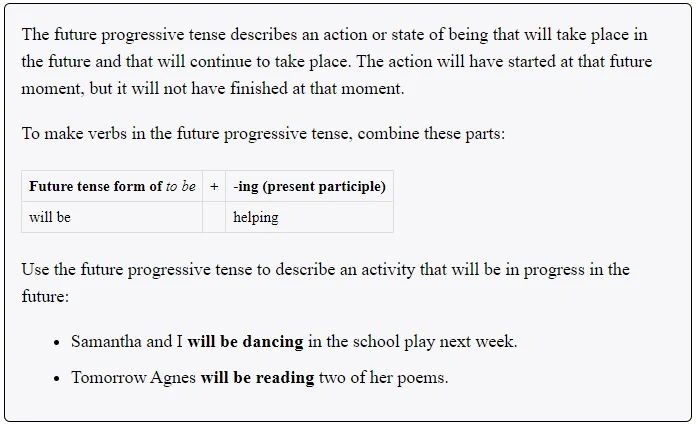
Exercise
On a separate sheet of paper, revise the following sentences, written in simple tenses, using the progressive tenses indicated in parentheses.
He prepared the food while I watched. (past progressive tense)
Jonathan will speak at the conference. (future progressive)
Josie traveled to Egypt last July. (past progressive tense)
My foot aches, so I know it will rain. (present progressive tense)
Micah will talk a lot when I see him. (future progressive)
I yawn a lot because I feel tired. (present progressive tense)
Gerunds
A gerund is a verb form utilized as a noun, and all gerunds conclude with -ing. Given that gerunds function as nouns, they occupy positions in a sentence, such as the subject, direct object, and object of a preposition, similar to how a noun would.
Here are various ways you can use a gerund:
As a subject:
Traveling is Cynthia’s favorite pastime.
As a direct object:
I enjoy jogging.
As an object of a preposition:
The librarian scolded me for laughing.
Additionally, gerunds are frequently employed after verbs. Refer to Table 5.8, "Gerunds and Verbs," for examples.
Table 5.8 Gerunds and Verbs
Infinitives
An infinitive is a verb form that follows the word "to" and functions as a noun, adjective, or adverb.
The structure is as follows:
to
+
verb
=
infinitive
to+verb=infinitive
Examples of infinitives include:
to move
to sleep
to look
to throw
to read
to sneeze
Infinitives are commonly used after verbs. Refer to Table 5.9, "Infinitives and Verbs," for illustrative examples.
Table 5.9 Infinitives and Verbs
You might be curious about which verbs accommodate both gerunds and infinitives. The following verbs allow for the use of either a gerund or an infinitive.
Exercise
On your own sheet of paper, complete the following sentences by choosing the correct infinitive or gerund.
I meant ________ (to kiss, kissing) my kids before they left for school.
The children hoped (to go, going) to a restaurant for dinner.
Do you intend ________ (to eat, eating) the entire pie?
Crystal postponed ________ (to get dressed, getting dressed) for the party.
When we finish ________ (to play, playing) this game, we will go home.
Rhetorical Modes (Modes of Development)
Writers can enhance organization in their work by employing standard Rhetorical Modes, also known as Modes of Development or Standard Patterns of Organization.
These modes serve as structured frameworks for organizing ideas. If you recall, you've already utilized this tool in the essays from Unit 3 and Unit 4, namely the Organization Essay and Compare/Contrast Essay. In those instances, the notes provided a framework, and you integrated your ideas into that structure to construct your essays.
While you became familiar with the structure for the Organization Essay and Compare/Contrast Essay, there exist other structures or Rhetorical Modes that you can leverage in subsequent essays for this course and in your future writing endeavors. These modes can be particularly beneficial as you embark on organizing your thoughts for the upcoming research paper in Unit 7.
Chapter 10: Rhetorical Modes
Rhetorical modes are essentially the various ways we use language to communicate effectively. This chapter delves into nine prevalent rhetorical modes. It's important to grasp that the choice of a specific mode by a writer hinges on their purpose for writing. Often, writers seamlessly blend multiple modes within a single essay. This chapter not only introduces these nine modes but also underscores them as a toolkit, empowering you with enhanced flexibility and efficacy in conveying your thoughts to your audience.
The Purpose of Narrative Writing
Narration, the craft of storytelling, lies at the heart of narrative writing, which aims to recount stories. When you share an incident from your day with a friend or family member, you're essentially engaging in narration. Narratives can take on the guise of fact or fiction. Factual narratives strive to adhere faithfully to real-life events, providing an account of occurrences as they unfolded. On the other hand, fictional narratives are products of imagination, allowing writers to fashion characters and events according to their creative vision.
The crucial distinction between factual and fictional narratives lies in the writer's intent. Factual storytellers aim to accurately relay events as they occurred, while creators of fictional tales have the liberty to deviate from reality, sculpting characters and events to suit their creative objectives. Biographies and memoirs exemplify factual storytelling, whereas novels and short stories epitomize the realm of fiction.
Navigating the sometimes ambiguous boundary between fact and fiction underscores the importance of clarifying your purpose from the outset. Do you aim to faithfully recount historical events, whether they be your own or someone else's? Alternatively, does your creative passion lead you to reimagine the world, molding it either into the likeness of your ideal vision or the fantastical realms of your imagination? The responses to these questions significantly influence the narratives you craft and the stories you choose to tell.
In essence, regardless of whether a narrative is rooted in fact or born from fiction, the core objective of narrative writing remains to vividly portray a sequence of events in a way that emotionally captivates the audience. The aim is to elicit a response, be it laughter, sympathy, fear, anger, or any other emotional nuance. The clarity with which you narrate your story directly correlates with the depth of emotional engagement your audience is likely to experience.
Exercise
On a separate sheet of paper, start brainstorming ideas for a narrative. First, decide whether you want to write a factual or fictional story. Then, freewrite for five minutes. Be sure to use all five minutes, and keep writing the entire time. Do not stop and think about what to write.
The following are some topics to consider as you get going:
Childhood
School
Adventure
Work
Love
Family
Friends
Vacation
Nature
Space
The Structure of a Narrative Essay
Primary narrative events are commonly presented in chronological order, aligning with the sequential unfolding of events from the initial occurrence to the final outcome. Stories conventionally follow a structure comprising a beginning, a middle, and an end, with events organized based on their occurrence in time. To assist readers in maintaining a clear sense of the story's chronology, certain transitional words and phrases play a crucial role. Refer to Table 10.1, titled "Transition Words and Phrases for Expressing Time," for a comprehensive list of these linguistic tools. For a more in-depth exploration of chronological order, delve into Chapter 8, "
The Writing Process: How Do I Begin?" and Chapter 9, "Writing Essays: From Start to Finish."
Table 10.1 Transition Words and Phrases for Expressing Time
Additional fundamental elements of a narrative include:
Plot: The unfolding sequence of events that propels the story forward.
Characters: The individuals who inhabit the narrative, steering its progression. Typically, there are minor characters playing supportive roles to the main character or protagonist.
Conflict: The central problem or obstacle embedded in the plot that the protagonist must navigate or resolve by the narrative's conclusion. How the protagonist addresses this conflict often shapes the theme of the narrative.
Theme: The underlying message or insight that the narrative endeavors to convey, which can be overt or subtly implied. It encapsulates the overarching meaning or purpose of the story.
Writing at Work
When employers inquire about challenges or conflicts during job interviews, they seek compelling personal narratives that highlight a candidate's ability to overcome obstacles. To effectively prepare for this question, it's beneficial to craft a scenario using the narrative mode structure. This approach not only helps troubleshoot any rough spots in your storytelling but also provides a deeper understanding of your personal history. By engaging in this process, you can enhance both the quality of your story and the overall presentation of yourself.
Consider recounting a specific incident that demonstrates your resilience, problem-solving skills, and capacity for growth. Begin by setting the scene, providing context to the challenge you faced. Delve into the emotions and thoughts you experienced at that time, allowing the interviewer to connect with your narrative on a personal level.
As you progress, emphasize the actions you took to address the issue and the strategies you employed to overcome obstacles. Highlight any collaboration or leadership skills that played a role in resolving the conflict. Reflect on the lessons learned and how the experience contributed to your personal and professional development.
Through the narrative mode structure, you not only shape a compelling story but also gain insights into your own journey. This introspective process enables you to articulate your experiences with clarity and purpose, ultimately enhancing your ability to present yourself as a resilient and resourceful candidate during the interview.
Writing a Narrative Essay
When embarking on the journey of crafting a narrative essay, the first pivotal decision lies in whether to weave a factual account or spin a tale from the realm of fiction. Begin by probing your creative inclination, pondering the realms of reality or the boundless expanse of imagination. Refer to Chapter 8, titled "
The Writing Process: How Do I Begin?" for a comprehensive exploration of freewriting, a technique that liberates your thoughts and aids in the exploration of topics that resonate with your curiosity.
Once you've identified the narrative's essence, sketch the contours of its major events, outlining a trajectory that will form the backbone of your plot. Arrange these events in a chronological cascade, building a crescendo that converges at a central conflict demanding resolution by the narrative's denouement. This meticulous structuring lays the foundation for a compelling narrative arc, guiding your reader through the peaks and valleys of your story.
In the architecture of your narrative, the deployment of vivid details assumes paramount significance. Elevate your storytelling by infusing life into events and characters through the meticulous use of sensory-rich descriptions. Enable the reader to not just witness but emotionally immerse themselves in the tapestry of your created world. It is through the artful selection and deployment of these details that you cultivate a profound connection between the reader and the narrative realm you've summoned into existence.
As you embark on your narrative odyssey, remember that the potency of your storytelling lies not merely in recounting events but in weaving a tapestry that resonates with the reader's emotions. Craft an immersive experience, compelling your audience to traverse the landscapes of your imagination with fervor and anticipation.
Forge potent details in your narrative by harnessing the rich tapestry of human senses. Immerse your reader in the vibrant world you craft by meticulously weaving details that evoke the realms of sight, sound, smell, taste, and touch. As you breathe life into your narrative's characters, settings, and events, envisage the sensory symphony that will resonate with your audience.
Engage your reader visually by painting vivid pictures with words, capturing the intricate details of people, places, and scenes. Enlist the power of descriptive language to evoke the colors, shapes, and nuances that define your narrative landscape. Let your reader not merely read but visualize, allowing the scenes to unfold like a captivating movie in their mind's eye.
Orchestrate a melodic experience by incorporating sounds that reverberate through your narrative. Whether it's the rustle of leaves, the distant hum of a city, or the melodic cadence of a character's voice, infuse auditory elements that enrich the reader's immersive journey. Make your narrative not just a story on paper but a symphony that resonates in the reader's imagination.
Transport your reader olfactorily by infusing your narrative with scents that linger in the air. Whether it's the aroma of freshly brewed coffee, the crisp scent of pine in a forest, or the pungent whiff of a bustling market, evoke a sensory atmosphere that envelops your audience. Imbue your writing with fragrances that linger in the reader's mind, enhancing the depth and authenticity of your narrative world.
Set the stage for an enthralling narrative by crafting a compelling introduction that beckons the reader to delve further into your story. Begin with an event that serves as a captivating portal into the narrative, igniting curiosity and prompting the reader to eagerly journey into the unfolding tale. Your introduction acts as the narrative's overture, beckoning the reader with an irresistible melody that promises a symphony of engaging storytelling to come. Consider this your literary handshake, a firm and intriguing grasp that propels your audience into the heart of your narrative.
As your story unfolds, guide the reader through a tapestry of events, characters, and emotions, building towards a central conflict that forms the narrative's beating heart. This conflict becomes the crucible in which your characters are tested and your plot is forged. Let the tension escalate, drawing the reader deeper into the narrative web you've skillfully woven.
In the symphonic crescendo of your narrative, the conclusion takes center stage. Here, seize the opportunity to bring resolution to the central conflict, providing a satisfying and impactful denouement. Weave the threads of your story together, ensuring that loose ends are tied and questions are answered. Beyond resolution, elevate your conclusion to transcend the confines of the narrative, leaving an indelible imprint on the reader's mind. This is the moment to impart the ultimate theme of your piece, imprinting a lasting impression that resonates beyond the final words.
Analyze the sample to glean insights into the art of storytelling, observing how the introduction entices, the narrative unfolds, and the conclusion leaves a lasting resonance. Let these examples serve as guideposts, inspiring you to hone your narrative craft and create a literary journey that captivates from beginning to end.
10.2 Illustration
The Purpose of Illustration in Writing
Illustration in an essay is akin to crafting a visual masterpiece—clearly demonstrating and reinforcing a point through compelling evidence. As expounded in
Chapter 9, where the craft of essay writing is meticulously dissected, the linchpin holding your essay together is the thesis, the guiding force that propels your narrative forward.
The arsenal of evidence at your disposal is diverse, and its effective deployment is an art. Scientific studies, expert opinions, statistical data, historical events, current affairs, analogies, and personal anecdotes—all wield the power to illuminate and reinforce your thesis. Your aim is to guide the reader through a visual journey, akin to the impact of a striking illustration in a magazine or on a website. The efficacy of your evidence is the brushstroke that paints a vivid image, allowing the reader to not just comprehend but vividly "see" your point.
However, navigating the terrain of evidence can be a nuanced task. Your choices should harmonize with both your subject matter and your audience. Tailor your evidence to resonate with your topic and the sensibilities of your readers. Consider the intricacies of your audience— their level of familiarity with the subject, their interests, and their background knowledge.
As you embark on crafting an illustration essay, be cognizant of a few key principles:
Appropriate Evidence Selection:
Align your evidence with the theme of your essay and the comprehension level of your audience. Your evidence should resonate with the context of your argument.
Assessing Evidence Quantity:
Gauge the depth of evidence needed based on the complexity of your subject and your audience's familiarity with it. Strive for a balance that provides clarity without overwhelming your reader.
For instance, imagine you're elucidating a new communication software. If your audience comprises English-major undergrads, employing an analogy or personal story might illuminate how the software functions. Conversely, if your audience consists of information technology specialists, a more technical evidence approach would be apt, given their familiarity with the subject matter.
In the symphony of evidence, your role as a writer is that of a conductor, orchestrating a harmonious blend that resonates with your audience, amplifies your thesis, and creates an indelible impression.
Strategically aligning your subject with the sensibilities of your audience enhances the likelihood of effectively illustrating your point. By maintaining a keen awareness of how your chosen subject resonates with your readers, you can tailor your approach, ensuring that your evidence strikes a chord with their interests, understanding, and background knowledge. This thoughtful consideration creates a bridge between your message and your audience, fostering a connection that facilitates a clearer, more impactful illustration of your central point. In essence, the art of effective illustration lies not just in the strength of your evidence but in the deliberate harmony between your subject matter and the receptive minds of your readers.
Strike a delicate balance in your writing by avoiding the pitfall of overexplaining concepts that your readers may already be familiar with. While it's crucial not to underestimate your audience's intelligence, clarity remains paramount. When navigating the fine line between presumption and precision, erring on the side of clarity often proves prudent.
In instances of uncertainty, consider the potency of additional examples to illuminate and fortify your ideas. These examples act as beacons, guiding your readers through the terrain of your argument without patronizing their intellect. The judicious inclusion of extra examples not only reinforces your point but also ensures that your message resonates unequivocally, fostering a deeper connection with your audience. In essence, the art lies not only in trusting your readers' comprehension but also in providing them with the tools they need to navigate your narrative with ease and understanding.
The Structure of an Illustration Essay
Crafting a well-organized essay requires strategic placement of the controlling idea and thoughtful sequencing of evidence. The thesis, acting as the compass guiding the reader, is best positioned at the essay's outset. Subsequently, the body paragraphs unfold, each serving as a supporting pillar for the central thesis.
The order in which evidence is presented can significantly impact the essay's effectiveness. One approach is to commence with the most compelling evidence, establishing a robust foundation for the argument. Alternatively, a crescendo strategy may be employed, commencing with less impactful evidence and culminating in the delivery of the most compelling points. This organizational technique, known as order of importance, was expounded upon in your exploration of Chapter 8, "
The Writing Process: How Do I Begin?" and Chapter 9, "Writing Essays: From Start to Finish."
In addition to the order of presentation, the strategic use of time transition words, as detailed in Table 10.1, can enhance the coherence of your essay. Terms such as "first," "second," "third," "currently," "next," and "finally" serve as guideposts, facilitating a smooth chronological flow and aiding readers in comprehending the temporal progression of your argument.
Given the nature of illustration essays, which rely heavily on examples, having a repository of words and phrases to introduce each piece of evidence is invaluable. Table 10.2, titled "Phrases of Illustration," provides an assortment of linguistic tools specifically tailored for this purpose. These phrases act as bridges, seamlessly connecting your ideas and ensuring a clear, illustrative representation of your thesis through a well-ordered sequence of evidence.
Table 10.2 Phrases of Illustration
Diversify the arsenal of phrases of illustration at your disposal; refrain from leaning heavily on a singular choice. The art of maintaining reader engagement hinges on the judicious use of a varied lexicon and phrasing. Employing a rich spectrum of linguistic expressions becomes pivotal when seeking to captivate your audience's attention and sustain their interest in your narrative and ideas.
Steer clear of monotonous repetition by exploring a myriad of phrases, ensuring a dynamic and captivating prose. The vitality of your writing lies in the nuanced interplay of diverse words and expressions that not only convey your message but also weave an intricate tapestry of language. This variance injects vitality into your narrative, preventing it from becoming stale or predictable.
By embracing linguistic diversity, you not only elevate the aesthetic appeal of your writing but also enhance its communicative efficacy. Your ideas, when adorned with a tapestry of varied phrases of illustration, become more vivid and resonant, capturing the reader's imagination and sustaining their interest throughout your discourse. So, venture beyond the confines of routine expression, exploring the vast terrain of language to infuse your writing with the vitality that stems from lexical diversity.
Writing at Work
In a professional setting, it proves advantageous to consistently bear in mind a repertoire of illustrative phrases, strategically integrating them into your communication. Whether you are articulating directives for colleagues to follow or soliciting a new product or service from another company, purposefully infusing your language with phrases of illustration compels you to offer tangible examples, thereby elucidating and reinforcing your intended message. This intentional incorporation not only ensures clarity in your communication but also fosters a deeper understanding among your audience, enhancing the effectiveness of your workplace interactions.
Writing an Illustration Essay
To embark on a compelling writing endeavor, begin by selecting a topic that genuinely captivates your interest. Craft an engaging introduction that entices the reader into the narrative, saving the central point, or thesis, for a powerful revelation at the conclusion of this initial section.
Thoroughly gather evidence that aligns seamlessly with both your chosen subject and the preferences of your audience. Strategic organization of this evidence is key—arrange it in a manner that accentuates its significance, whether by progressing from the least to the most important or vice versa. Each piece of evidence should be meticulously expounded upon, employing robust and transparent supporting details to fortify your argument.
10.3 Description
The Purpose of Description in Writing
Writers skillfully employ description as a literary tool to ensure their audience is not just reading words but fully immersed in the vivid tapestry of the narrative. This immersive experience demands a deliberate effort from the writer to articulate their world through the intricate brushstrokes of sensory details.
As previously emphasized in this chapter, sensory details are the lifeblood of descriptions, weaving a rich tapestry that appeals to our senses of sight, sound, smell, taste, and touch. By honing in on these senses, writers tap into a universal human experience—we all navigate the world through these sensory channels. The strategic incorporation of sensory details, therefore, presents an unparalleled opportunity to establish a profound connection with the audience, drawing them into the narrative and fostering engagement.
This emphasis on descriptive writing extends beyond the confines of academia; it is a potent tool applicable in everyday situations. Whether you are narrating an educational piece or articulating the nuances of your daily experiences, the artful inclusion of sensory details elevates your writing, making it a vibrant and compelling reflection of the world you seek to convey. In essence, descriptive writing emerges as a vital skill, not only for educational pursuits but as a dynamic instrument for enriching communication in the tapestry of everyday life.
Steer clear of vague descriptors whenever feasible. Empty descriptors, such as "good," "beautiful," "terrific," and "nice," possess a subjective quality that may yield varied interpretations among different individuals. The ambiguity of these adjectives can result in misreads and confusion, as their meaning may shift depending on factors like age, personality, or personal preferences.
For instance, deeming a day as "good" could carry vastly different connotations for individuals with distinct perspectives or tastes. To enhance clarity and precision in your descriptions, opt for more specific and nuanced language. Instead of relying on broad terms, consider employing detailed adjectives that provide a clearer picture, fostering a shared understanding among diverse readerships.
By circumventing the use of empty descriptors, you fortify your writing with a level of specificity that transcends subjective interpretation, promoting a more universally resonant and unambiguous communication of your ideas.
In scenarios ranging from presenting a novel product or service to a client, orienting new employees, or collaboratively brainstorming with colleagues, the incorporation of clear and evocative details holds paramount significance. Strive to employ details that vividly articulate your thoughts, ensuring resonance with your audience. The use of sharp, concise details not only leaves a lasting impression but also enhances the effectiveness of your communication, fostering a deeper understanding among those you engage with.
Exercise
On a separate sheet of paper, describe the following five items in a short paragraph. Use at least three of the five senses for each description.
Night
Beach
City
Dinner
Stranger
The Structure of a Descriptions Essay
Descriptions essays, which skillfully capture the essence of a person, place, or object through sensory details, exhibit a distinctive flexibility in structure compared to other rhetorical modes. The introductory phase of a descriptive essay plays a pivotal role in establishing the tone and focal point. Here, the thesis serves as the beacon, encapsulating the writer's overarching impression of the subject that will unfold in the subsequent body paragraphs.
The organization of a descriptive essay often finds resonance with spatial order—a meticulous arrangement of ideas based on physical characteristics or appearance. The progression may navigate from top to bottom, left to right, or meander from near to far, warm to cold, or even transition from the frightening to the inviting, depending on the nature of the subject.
Consider, for instance, the depiction of a client's kitchen in the throes of renovation. The chosen spatial order could initiate the narrative from one side of the room, meandering deliberately to the other, unraveling the details of appliances, cabinetry, and more. Alternatively, the essay might commence with the remnants of the old kitchen, progressing methodically to showcase the new installations. The spatial order could be akin to starting from the floor and ascending toward the ceiling, artfully guiding the reader through a sensory journey of the evolving kitchen space.
Writing a Description Essay
The inaugural step in crafting a description essay is the careful selection of a subject—be it a person, place, or object. Once the subject is chosen, the task at hand is to sculpt an impactful thesis statement that will serve as the North Star guiding the entire essay.
The subsequent sections of your essay unfold as a deliberate exploration, intricately weaving sensory details to give life to your chosen subject in a manner that resonates with your thesis. It's imperative to have a clear organizational strategy for your essay, and once chosen, steadfastly adhere to it.
Each facet of your essay should be adorned with vivid sensory details, a palette of sensations that invites your readers into the immersive world you are describing. The more you can evoke your readers' senses, the more profoundly they will be drawn into the tapestry of your essay. For a tangible example, consult Chapter 15, "Readings: Examples of Essays," where you can delve into a sample description essay to glean insights into the effective application of these principles.
10.4 Classification
The Purpose of Classification in Writing
The essence of classification lies in the art of deconstructing expansive subjects into more digestible, specific components. In our daily lives, classification is an innate process, seamlessly woven into our thoughts and actions. Take, for instance, the ubiquitous cell phone, now entrenched within a vast category. Within this overarching classification, we discern the finer distinctions, categorizing them as feature phones, media phones, and smartphones.
The creation of these smaller categories, and the method by which they are delineated, serves a profound purpose—helping us decipher and make sense of the complexities of our world. As you embark on crafting a classification essay, be mindful of both these elements. Consider the power vested in the breakdown of broader subjects into more manageable components, and the clarity that emerges when these components are systematically organized into smaller categories. In doing so, you not only navigate the intricacies of your subject but also guide your readers through a structured and coherent exploration of the diverse facets within the broader realm you're classifying.
Opt for topics that you possess a deep understanding of when delving into the realm of classification essays. The richness of your knowledge forms the bedrock for dissecting the subject into compelling, nuanced components. The more intimate your familiarity with a topic, the more adeptly you can navigate its intricacies, unraveling it into smaller, captivating facets.
Infusing your classification essays with interest and insight becomes second nature when you draw from a reservoir of profound knowledge. Your expertise not only facilitates the dissection of the subject into smaller parts but also empowers you to offer unique perspectives and compelling insights. This not only captivates your readers but elevates the overall quality of your classification essay, transforming it into a nuanced exploration that goes beyond the surface level.
In essence, the connection between your familiarity with the chosen topic and the vibrancy of your essay is symbiotic. Your in-depth knowledge fuels the ability to break down the subject into engaging components, while the process of classification, in turn, enhances the depth and sophistication of your understanding.
The Structure of a Classification Essay
To craft an effective classification essay, the introductory paragraph serves as the gateway, ushering the reader into the broader topic at hand. Within this inaugural segment, the thesis statement takes center stage, elucidating not only the existence of subgroups within the overarching theme but also offering a rationale for their categorization. Consider the following example as a template for such an introductory paragraph:
In the intricate tapestry of culinary delights, desserts emerge as a delectable category that beckons exploration. From the ethereal world of pastries to the decadence of chocolates, the realm of desserts is a tantalizing playground for the palate. This classification essay aims to dissect the dessert domain, revealing the diverse subgroups that exist within this indulgent sphere. By delving into the distinctions between cakes, pies, and frozen treats, we not only embark on a flavorful journey but also unravel the reasons behind their categorization. Whether it's the texture, ingredients, or cultural influences, each subgroup possesses its own unique charm, contributing to the sumptuous symphony that is the world of desserts.
When people think of New York, they often think of only New York City. But New York is actually a diverse state with a full range of activities to do, sights to see, and cultures to explore. In order to better understand the diversity of New York state, it is helpful to break it into these five separate regions: Long Island, New York City, Western New York, Central New York, and Northern New York.
The highlighted thesis not only articulates the specific category and its subcategories but also provides a clear rationale for the chosen classification. Through the lens of this classification essay, the writer aspires to offer readers a novel perspective on understanding the state.
Each body paragraph in a classification essay is a dedicated canvas for fully illustrating each of the subcategories. For instance, in the previous example, every region of New York would merit its paragraph, unraveling the distinct characteristics that define and differentiate them.
As the narrative unfolds, the conclusion assumes the crucial role of weaving together all the categories and subcategories, presenting the reader with a comprehensive view. In the context of the previous example, the conclusion becomes the stage for elucidating how the diverse sights and activities in each region contribute synergistically to the state's overall richness, fostering a nuanced understanding of its diversity and complexity.
Guard against the trap of oversimplification in your classification endeavors by diligently dissecting any given topic in at least three distinct ways. This intentional approach not only enhances the depth of your analysis but also prompts you to explore beyond conventional boundaries, potentially unearthing novel facets of the subject matter.
By committing to delineating a topic into a minimum of three different categories, you challenge yourself to think expansively and delve into nuanced dimensions. This multifaceted exploration not only enriches your understanding of the subject but also opens the door to the possibility of discovering entirely new perspectives and insights.
In essence, the tripartite classification strategy serves as a catalyst for creativity and a guardrail against simplistic categorization, ensuring a more comprehensive and enlightening exploration of the topic at hand.
Writing a Classification Essay
Commence your classification essay with a captivating opening that effectively introduces the overarching topic, paving the way for its subsequent division into smaller, distinctive subcategories. Your thesis, positioned at the conclusion of the introduction, acts as the compass for your essay. Utilize the classification thesis equation:
topic+subtopics+rationale for the subtopics=thesis.
The organizational structure of your classification essay is intricately linked to the initial topic and its ensuing subtopics. Each body paragraph serves as a dedicated canvas, fully illustrating one of the subtopics. The process of selecting a robust topic not only provides substance but also lays the groundwork for a well-organized essay.
When delving into each subcategory, employ robust details and explanations that elucidate and fortify your thesis. Incorporate illustrative examples to vividly exemplify your points, ensuring a compelling narrative that resonates with your readers.
Conclude your essay by skillfully linking all the subgroups, effectively wrapping up your discourse and reconnecting it to the topic initially introduced in the introduction.
10.5 Process Analysis
The Purpose of Process Analysis in Writing
A process analysis essay serves the purpose of elucidating how to do something or comprehending the workings of a particular process. In essence, the formula for a process analysis essay remains constant: the process is methodically broken down into clear, definitive steps.
Throughout our lives, a myriad of activities necessitates adherence to step-by-step processes. Whether it's the rite of passage of riding a bike in childhood or mastering various adult tasks, effective execution invariably hinges on a systematic approach. Just as we have relied on instructions to navigate these processes, we've likely found ourselves in the role of instructors, underscoring the paramount importance of clear directions—and the frustration that ensues when they are poorly articulated.
Writing at Work
When tasked with explaining a process to a colleague at work, pay meticulous attention to the clarity with which you articulate each step. Proficiency in communication stands as a linchpin for workplace satisfaction and advancement. The ability to execute effective process analysis not only enhances your proficiency in this vital skill set but also plays a pivotal role in fostering workplace success.
Exercise
On a separate sheet of paper, make a bulleted list of all the steps that you feel would be required to clearly illustrate three of the following four processes:
Tying a shoelace
Parallel parking
Planning a successful first date
Being an effective communicator
The Structure of a Process Analysis Essay
The inception of a process analysis essay involves a thoughtful exploration of the process at hand, accompanied by a thesis statement that succinctly articulates the objective of the process.
Typically, the organization of a process analysis essay adheres to chronological order. The steps constituting the process unfold in the sequence in which they commonly occur. Body paragraphs are meticulously crafted to align with these steps, with a nuanced approach to paragraph construction—elaborating extensively on complex steps and consolidating straightforward ones into a single paragraph for clarity.
In orchestrating the seamless progression of ideas, the integration of time transition phrases becomes instrumental. Drawing from the Narration and Illustration sections, refer to Table 10.1 "Transition Words and Phrases for Expressing Time" and Table 10.2 "Phrases of Illustration." Utilizing words like "first," "second," "third," "next," and "finally" serves as invaluable cues, facilitating reader orientation and harmonizing the content of the essay in a coherent temporal flow.
Ensuring the clarity of your process analysis is crucial, and the perspective of a fresh set of eyes is invaluable in achieving this. As individuals, we may become so immersed in a subject that gauging the clarity of our ideas becomes challenging. Engage a friend or coworker to read your analysis, providing an external perspective that can serve as an effective troubleshooting mechanism for any potentially confusing elements. This collaborative approach not only identifies potential pitfalls but also enhances the overall comprehensibility and effectiveness of your process analysis.
Writing a Process Analysis Essay
When selecting a topic for a process analysis essay, opt for one that is not only intriguing but also inherently complex, allowing for a detailed exploration in a series of steps. Choose a process within your realm of expertise to effortlessly delve into the nuanced intricacies. Your thesis, positioned at the conclusion of the introduction, should succinctly unveil the ultimate outcome of the process under scrutiny.
Each body paragraph becomes a canvas for delineating a step in the process. Infuse these steps with robust details and vivid examples to ensure clarity and engagement. Employ time transition phrases adeptly to seamlessly organize the steps and guide readers through the process.
In the conclusion, meticulously detail the culmination of the process, summarizing the journey outlined in the body paragraphs.
10.6 Definition
The Purpose of Definition in Writing
While the purpose of a definition essay may initially appear straightforward — to provide a definition for something — the process is often more intricate than a simple dictionary consultation. The manner in which we define terms holds profound implications for individuals and societal groups alike.
Consider the term "alcoholism" as an example. Its definition is contingent upon legal, moral, and medical contexts. Lawyers may frame it in terms of legality, parents in terms of morality, and doctors through symptoms and diagnostic criteria. Broader cultural debates, such as those surrounding terms like "marriage" and "climate change," highlight the immense impact of definitions on policy and daily decisions. Words like commitment, respect, or love can be sources of debate in relationships, emphasizing the pivotal role of clear definitions in effective communication.
Though initially challenging, establishing definitions within relationships or any context facilitates productive dialogues. Definitions serve as the scaffolding for how people convey ideas, setting parameters for discourse and underlining their critical importance.
When venturing into the realm of definition essays, steer clear of terms that are overly simplistic or lack complexity. Opt for concepts rather than physical objects, delving into realms such as heroism, immigration, or loyalty. These conceptual choices not only offer richer, more nuanced explorations but also tend to be fluid and contentious, paving the way for more effective and engaging definition essays. By focusing on concepts, you enter terrain where definitions are dynamic, subject to interpretation and debate, thereby fostering a more compelling and thought-provoking exploration of the chosen term.
Writing at Work
Definitions wield significant influence in every workplace setting. Consider the term "sexual harassment," for instance. While there exists a broad federal definition, individual companies often supplement it with additional criteria to provide a more nuanced understanding. Familiarizing yourself with how your workplace precisely defines and addresses sexual harassment allegations is essential. Extend this consideration to other terms within your organization, such as "lateness," "productivity," or "contributions." Each of these terms likely carries specific company-defined parameters that shape workplace expectations and behaviors. Awareness of these definitions is integral to fostering a healthy work environment and promoting mutual understanding among colleagues.
The Structure of a Definition Essay
In the realm of definition essays, the introductory phase initiates with a broad discourse on the term to be defined, culminating in the thesis where you articulate your specific definition of the term.
Subsequent sections of the essay unfurl the rationale behind your chosen definition. While dictionary entries are limiting, your essay should transcend these constraints. Context, denoting the circumstances, conditions, or setting in which a term exists, becomes paramount. Words often assume diverse meanings based on the context in which they are employed. For instance, the attributes of an ideal leader in a battlefield setting may markedly differ from those in an elementary school setting. If an essay lacks contextual clarity, it may risk being too brief or lead to confusion and misunderstandings.
The remaining segments of the essay meticulously expound on various facets of the term's definition. For instance, if defining a good leader in an elementary classroom setting, you might delineate the qualities based on personality traits such as patience, consistency, and flexibility. Each attribute finds its dedicated space in the essay, with individual paragraphs providing comprehensive explanations. This approach not only adds depth to the definition but also ensures clarity and a nuanced exploration of the chosen term.
When tackling definition essays, consider delving into concepts that hold personal significance for you. Crafting an engaging definition essay is more probable when you choose an idea that carries personal value and importance. Your investment in the concept not only enhances your connection with the topic but also infuses your writing with authenticity and passion, capturing the attention and interest of your readers. By choosing a concept with which you have a personal stake, you not only bring a unique perspective to the essay but also ensure a more compelling and meaningful exploration of the chosen term.
Writing at Work
Regularly evaluating your role in the workplace is a prudent practice. You can engage in this self-assessment through the process of definition. Identify your role by not only defining the routine tasks but also scrutinizing the gray areas where your responsibilities might intersect with those of others. Articulating a clear definition of roles and responsibilities not only enhances your professional clarity but also adds value to your résumé. Moreover, it has the potential to bolster workplace productivity by fostering a more streamlined and efficient work environment.
Writing a Definition Essay
When selecting a topic for a definition essay, opt for one that allows for in-depth discussion. Choosing a word or phrase with personal relevance often leads to a more captivating and engaging essay.
After selecting your word or phrase, commence your essay with an introduction that establishes the term's relevance within a specific context. Position your thesis at the end of the introduction, clearly stating your definition of the term in this particular context. Establishing a functional context from the outset ensures reader orientation and minimizes misunderstandings.
Devote each body paragraph to elucidating a distinct facet of your definition. Employ clear examples and robust details to illustrate your points. The concluding paragraph should seamlessly weave together the various elements of your definition, reinforcing your thesis.
10.7 Comparison and Contrast
The Purpose of Comparison and Contrast in Writing
Comparison in writing involves discussing elements that are similar, while contrast delves into elements that differ. A compare-and-contrast essay, therefore, scrutinizes two subjects by both comparing and contrasting them.
The essence of a successful compare-and-contrast essay lies in selecting two or more subjects that share a meaningful connection. The goal isn't to state the obvious but to unveil subtle differences or unexpected similarities. For instance, instead of comparing apples and oranges, which might be too obvious, a more nuanced approach would be to compare and contrast two types of oranges or two types of apples, emphasizing subtle distinctions. Red Delicious apples, for instance, are sweet, while Granny Smiths are tart and acidic. Drawing these distinctions within a similar category enhances the audience's understanding, constituting the core purpose of a compare-and-contrast essay.
Conversely, to emphasize comparison, choose initially unrelated subjects. Opting for two apples or two oranges might not be as compelling since they already share numerous properties. Instead, aim to compare how apples and oranges, despite seeming dissimilar, share surprising similarities. The more seemingly divergent the subjects, the more intriguing and enlightening the comparison essay becomes.
Writing at Work
Comparison and contrast serve as evaluative tools, essential for making accurate assessments about a given topic. Before rendering judgments, understanding the critical points of similarity and difference is paramount. This evaluative approach is prevalent in various workplace assessments, where comparing and contrasting play pivotal roles.
In the professional realm, it's common to compare and contrast oneself with colleagues, a practice integral to decisions regarding employee advancements, pay raises, hiring, and terminations. This method is not limited to individuals; it extends to evaluating companies, departments, or various organizational elements.
In essence, the act of comparing and contrasting serves as a lens through which to discern distinctions and similarities, facilitating informed and objective evaluations critical to effective decision-making in the workplace.
Exercise
Brainstorm an essay that leans toward contrast. Choose one of the following three categories. Pick two examples from each. Then come up with one similarity and three differences between the examples.
Romantic comedies
Internet search engines
Cell phones
Brainstorm an essay that leans toward comparison. Choose one of the following three items. Then come up with one difference and three similarities.
Department stores and discount retail stores
Fast food chains and fine dining restaurants
Dogs and cats
The Structure of a Comparison and Contrast Essay
The foundation of a compare-and-contrast essay lies in a thesis that distinctly outlines the two subjects slated for comparison, contrast, or both, along with the rationale behind this exploration. The thesis may incline more toward emphasizing comparison, contrast, or strike a balance between the two. It's essential to keep in mind that the purpose of comparing and contrasting is to impart meaningful knowledge to the reader.
Consider the following thesis as an example, showcasing a tendency more toward contrasting:
"While both classical and operant conditioning are psychological theories of learning, their underlying principles diverge significantly in terms of reinforcement mechanisms and the nature of learned behaviors."
This thesis foreshadows an essay that delves into the distinctions between classical and operant conditioning, emphasizing the contrasting elements within these two psychological theories.
Thesis statement: Organic vegetables may cost more than those that are conventionally grown, but when put to the test, they are definitely worth every extra penny.
The thesis here establishes the groundwork for comparing and contrasting two subjects—organic versus conventional vegetables—and makes a claim about the potential usefulness of the results to the reader.
When organizing compare-and-contrast essays, you can adopt one of the following two approaches:
Subject-by-Subject Organization:
Discuss one subject comprehensively and then transition to the other. This method provides a thorough examination of each subject individually.
Point-by-Point Organization:
Discuss each subject in relation to specific points, allowing for a direct comparison of individual aspects. This approach is effective for highlighting similarities and differences systematically.
Refer to Figure 10.1 "Comparison and Contrast Diagram" for a visual representation of how to organize the organic versus conventional vegetables thesis using these two methods.

The organizational structure you select for your compare-and-contrast essay should align with the nature of the topic, your purpose, and your audience.
As compare-and-contrast essays delve into the relationship between two subjects, having a repertoire of phrases at your disposal can effectively cue the reader to the analytical nature of your discussion. Refer to Table 10.3 "Phrases of Comparison and Contrast" for examples that can seamlessly integrate into your writing, facilitating a smooth transition between points of comparison and contrast. These phrases serve as valuable signposts, guiding the reader through the nuanced exploration of similarities and differences within your essay.
Writing a Comparison and Contrast Essay
When crafting a compare-and-contrast essay, begin by deciding whether you want to compare seemingly disparate subjects, contrast seemingly similar subjects, or do both. Once the topic is chosen, initiate the essay with an engaging opening paragraph. Situate your thesis at the conclusion of the introduction, clearly delineating the subjects to be compared, contrasted, or both, and articulating what insights can be gleaned from this exploration.
The body of the essay can be organized in one of two ways: by subject or by individual points. The choice of organizing strategy depends on your audience, purpose, and the nature of the subjects. Some subjects may naturally align with one structure over the other. Integrate comparison and contrast phrases judiciously to guide the reader through the analytical examination of the subjects' relationship.
Upon concluding the analysis of the subjects, craft a conclusion that summarizes the main points of the essay and reinforces your thesis.
Writing at Work
Comparison and contrast strategies, whether organized by subject or individual points, are not only effective for essays but also find valuable application in business presentations. When faced with the task of organizing a presentation, consider employing these strategies to enhance clarity and engagement.
Whether you're contrasting different approaches, comparing various solutions, or analyzing the strengths and weaknesses of different strategies, the principles of comparison and contrast can bring a structured and insightful framework to your business presentations. This approach allows your audience to grasp the nuances of the information more effectively, fostering a deeper understanding of the subject matter.
The next time you or a colleague is tasked with delivering a presentation at work, keep the organizational strategies of comparison and contrast in mind. Whether outlining subjects individually or dissecting points of comparison, this approach can contribute to a more coherent and impactful business presentation.
10.8 Cause and Effect
The Purpose of Cause and Effect in Writing
It is ingrained in human nature to inquire about the "why?" and "how?" of various situations. We seek to understand the cause of our child's illness to prevent its recurrence, or we question why a colleague received a pay raise when we desire one as well. We contemplate the potential long-term savings from purchasing a hybrid car. These examples represent just a fraction of the many relationships we ponder in our lives, underscoring the significance of comprehending cause and effect.
In the realm of cause and effect, a cause is the factor that gives rise to an event or condition, while an effect is the outcome resulting from that event or condition. The cause-and-effect essay aims to explore how different phenomena are interlinked in terms of their origins and outcomes. While the connection between cause and effect is sometimes evident, in many instances, determining the precise relationship between the two proves challenging. For instance, the effects of a cold, such as a sore throat, runny nose, and cough, may be readily identifiable. However, pinpointing the cause of the sickness can be considerably more intricate. Multiple causes are conceivable, and to further complicate matters, these potential causes may have converged to bring about the illness. In essence, more than one factor may contribute to a given effect. Consequently, cause-and-effect discussions are often intricate and prone to debates and arguments.
Leverage the intricate nature of cause and effect to your advantage. In many instances, it is neither essential nor feasible to pinpoint the precise cause of an event or name the exact effect. Therefore, when constructing a thesis for a cause-and-effect essay, you can assert that one of several causes or effects is the principal or primary contributor. The moment you assert that a particular cause or effect holds more significance than the others, you have effectively formulated a thesis for your essay. This approach allows for a nuanced exploration of the complex relationships between various factors, providing room for analysis and interpretation within the framework of cause and effect.
Exercise
Consider the causes and effects in the following thesis statements. List a cause and effect for each one on your own sheet of paper.
The growing childhood obesity epidemic is a result of technology.
Much of the wildlife is dying because of the oil spill.
The town continued programs that it could no longer afford, so it went bankrupt.
More young people became politically active as use of the Internet spread throughout society.
While many experts believed the rise in violence was due to the poor economy, it was really due to the summer-long heat wave.
Write three cause-and-effect thesis statements of your own for each of the following five broad topics.
Health and nutrition
Sports
Media
Politics
History
The Structure of a Cause-and-Effect Essay
The cause-and-effect essay commences with a broad introduction to the topic, culminating in a thesis that articulates the primary cause, primary effect, or various causes and effects of a particular condition or event.
The organizational structure of a cause-and-effect essay can follow one of two primary methods:
Cause-Then-Effect Structure:
Begin by discussing the cause and subsequently delve into the effects.
Effect-Then-Cause Structure:
Commence by exploring the effect and then transition to discussing the causes.
For instance, in an essay on childhood obesity, you could either initiate the discussion by highlighting the effects of childhood obesity and then explore its causes, or begin by examining the causes and subsequently delve into the effects.
Irrespective of the chosen structure, ensure comprehensive and detailed explanations for each aspect of the essay. Unraveling intricate relationships necessitates the exhaustive use of evidence, ranging from scientific studies and expert testimony to statistics and anecdotes.
Given that cause-and-effect essays scrutinize the connections between phenomena, they frequently incorporate specific words and phrases that signify causation. Refer to Table 10.4 "Phrases of Causation" for examples of terms that effectively convey these linkages.
Table 10.4 Phrases of Causation

The conclusion of a cause-and-effect essay should serve to encapsulate the discussion and reaffirm the thesis, providing the reader with a lucid comprehension of the analyzed relationship. This final section is an opportunity to summarize key points, highlight the significance of the explored cause-and-effect dynamics, and leave a lasting impression on the reader. A well-crafted conclusion reinforces the central theme and solidifies the reader's understanding of the intricate connections explored throughout the essay.
Exercise caution to avoid relying on empty speculation in your writing. In the context of writing, speculation entails making unsupported guesses. Writers may be susceptible to such pitfalls, especially in cause-and-effect arguments, given the intricate nature of establishing connections between phenomena. It is imperative to ensure that your claims are substantiated with clear and compelling evidence, guarding against the pitfalls of unfounded conjecture.
Writing a Cause-and-Effect Essay
Select an event or condition that you find to have an intriguing cause-and-effect relationship. Begin your essay with a captivating introduction that draws the reader in. Conclude the introduction with a thesis statement that clearly articulates the main cause, the main effect, or both.
Organize your essay by adopting either the cause-then-effect or effect-then-cause structure. In each section, provide a thorough explanation supported by a comprehensive range of evidence for the causes and effects. If your essay addresses multiple causes or effects, consider sequencing them based on their order of importance. This could involve ordering causes from least to most important (or vice versa) or arranging effects from least important to most important (or vice versa).
When establishing connections between different events or conditions, utilize phrases of causation. These phrases serve to structure your ideas and guide the reader through the narrative. Conclude your essay with a summary of the main points and a reinforcement of your thesis.
10.9 Persuasion
The Purpose of Persuasive Writing
The aim of persuasion in writing is to sway, inspire, or prompt readers to embrace a specific point of view or opinion. The very act of persuasion implies the existence of multiple perspectives on the subject that can be debated.
Contrary to the often confrontational image associated with the term "argument," in writing, an argument takes on a more nuanced form. It constitutes a rational viewpoint substantiated and elucidated by evidence. To engage in written argumentation is to contribute to the expansion of knowledge and the exchange of ideas in a constructive manner. Written arguments are most effective when they rely on reasoning rather than resorting to impassioned outbursts.
It's a common inclination for many of us to strive for victory in the arguments we participate in. There's an inherent desire to be proven right, and we often hope to enlighten others about the potential flaws in their perspectives. Yet, in many cases, engaging in battles where both sides vie for triumph results in collective losses. A more constructive and productive approach involves persuading your audience to view your opinion as a valid perspective, not merely as the right one. This approach fosters a climate of understanding and encourages thoughtful consideration rather than fostering a winner-takes-all mentality.
The Structure of a Persuasive Essay
The following five features make up the structure of a persuasive essay:
Introduction and thesis
Opposing and qualifying ideas
Strong evidence in support of claim
Style and tone of language
A compelling conclusion
Creating an Introduction and Thesis
The persuasive essay embarks on its journey with a compelling introduction that introduces the overarching topic. Within the introduction, the thesis, which articulates the writer's viewpoint, typically finds its place, guiding the reader on the author's stance.
Steer clear of constructing a thesis founded on a negative claim. For instance, the statement "The hourly minimum wage is not high enough for the average worker to live on" may be accurate, but persuasive arguments are more effective when they present a positive case. Therefore, the thesis statement should emphasize how the hourly minimum wage is low or insufficient, framing the argument in an affirmative light.
Acknowledging Opposing Ideas and Limits to Your Argument
In crafting your argument, it is crucial to acknowledge opposing ideas, as an argument inherently involves varying perspectives on the subject. Avoiding conflicting ideas might give the impression of uncertainty, fearfulness, or lack of awareness. Therefore, addressing counterarguments is not only essential but should be done respectfully.
Consider addressing opposing arguments early in your essay. Rhetorically, placing your positive arguments last enables a more effective counterargument, allowing you to spend the rest of the essay countering those opposing views. This strategic order ensures that your readers conclude the essay contemplating your argument, leaving a lasting impression.
Acknowledging diverse points of view not only enhances credibility but also establishes a connection with your audience. By demonstrating awareness of opposing ideas, you convey a willingness to engage in a thoughtful dialogue.
Additionally, it is beneficial to define the limits of your argument and clarify your objectives. By acknowledging early on that your argument is not the definitive authority on the topic, you exhibit humility. This humble approach contributes to building credibility and trust with your audience. The audience recognizes that you are a reasonable writer, fostering trust in your argument. For instance, consider the following concessionary statement from a writer advocating for stricter gun control laws while admitting that it won't solve all crime problems:
Although tougher gun control laws are a powerful first step in decreasing violence in our streets, such legislation alone cannot end these problems since guns are not the only problem we face.
A concession of this nature is likely to be well-received by those who may initially disagree with the writer's argument. To persuade effectively, writers should adopt modest goals and approach their audience with humility to encourage receptiveness to their ideas. Refer to Table 10.5 "Phrases of Concession" for valuable expressions that can be employed in effectively conceding points in your writing.
Table 10.5 Phrases of Concession
Exercise
Try to form a thesis for each of the following topics. Remember the more specific your thesis, the better.
Foreign policy
Television and advertising
Stereotypes and prejudice
Gender roles and the workplace
Driving and cell phones
Bias in Writing
Everyone harbors various biases on a myriad of topics. Whether it's a preference for wearing black over brightly colored clothes, choosing jeans instead of formal wear, opting to work at night rather than in the morning, or adhering to deadlines instead of completing tasks in advance, these examples highlight minor biases that underscore individual preferences and opinions.
Dealing with bias, both in writing and daily life, is a valuable skill. It enables you to express your viewpoints while also safeguarding yourself against unreasonable perspectives. In persuasive writing, the goal is to transparently communicate your bias to the reader without letting it obscure the fundamental elements of compelling argumentation: sound, thoughtful evidence, and a respectful, reasoned engagement with opposing views.
The power of a personal bias lies in its ability to drive the construction of a robust argument. When you are emotionally invested in a topic, your commitment and passion for the writing increase. Consequently, you are more likely to invest time and effort, resulting in a higher-quality final product.
However, the weakness of bias emerges when it starts to dominate the essay. This occurs when opposing ideas are neglected, points are exaggerated, or the writer consistently places themselves ahead of the subject by using "I" excessively. Recognizing and avoiding these pitfalls ensures that bias contributes to, rather than detracts from, the strength of your writing.
The Use of I in Writing
The use of "I" in writing is a topic that often sparks debate, and its acceptance can vary from instructor to instructor. While it's challenging to predict the preferences of all your present and future instructors, it's crucial to consider the potential effects on your writing.
Exercise caution with the frequent use of "I" in your writing, as it can make your argument appear overly biased. There are two primary reasons for this:
Excessive Repetition: Repeating any word too often can draw the reader's attention in a negative way, and the use of "I" is no exception.
Altered Sentence Composition: The insertion of "I" into a sentence not only affects its sound but also changes the structure of the sentence itself. "I" often becomes the subject of a sentence. If the essay's subject is, for example, smoking, inserting yourself into the sentence displaces the primary subject of the essay. In the following example, the underlined portion represents the subject of the sentence:
Smoking is bad.
I think smoking is bad.
In the first sentence, the rightful subject, "smoking," occupies the subject position in the sentence. However, in the second sentence, the insertion of "I" and "think" replaces "smoking" as the subject, shifting attention to the writer rather than the intended topic. It's important to maintain a distinction between the message (the subject) and the messenger (the writer).
Checklist
Developing Sound Arguments
Does my essay contain the following elements?
An engaging introduction
A reasonable, specific thesis that is able to be supported by evidence
A varied range of evidence from credible sources
Respectful acknowledgement and explanation of opposing ideas
A style and tone of language that is appropriate for the subject and audience
Acknowledgement of the argument’s limits
A conclusion that will adequately summarize the essay and reinforce the thesis
Fact and Opinion
Facts are statements that can be definitively proven using objective data, representing information that is unquestionably valid. For instance, the equation 2 + 2 = 4 is a fact because it can be verified with objective data.
On the other hand, opinions are personal viewpoints or judgments, reflecting an individual's beliefs about a specific subject. In argumentation, opinions should be supported by legitimate evidence and credibility. Expert opinions carry weight due to the knowledge and credentials of the individuals expressing them. For instance, you may value the opinion of your dentist regarding gum health and the opinion of your mechanic on car maintenance. However, the authority of these opinions diminishes outside their respective fields.
Effective writing involves achieving a balance between presenting credible facts and authoritative opinions. Over Reliance on either element can potentially alienate parts of your audience rather than engaging them.
The term "prove" is commonly employed in discussions about persuasive writing. Writers may assert that a particular piece of evidence proves their argument, but achieving absolute proof in a debatable topic is often unattainable. The very nature of a debatable topic implies that no evidence definitively settles the matter. While facts can be proven, opinions can only be supported, explained, and persuaded.
Using Visual Elements to Strengthen Arguments
Enhancing a persuasive argument can be achieved by incorporating visual elements, which generally fall into two categories: quantitative visuals and qualitative visuals.
Quantitative visuals present data graphically, enabling the audience to perceive statistics spatially. These visuals aim to make logical appeals by providing a visual representation of numerical information. Examples include bar graphs, pie charts, Venn diagrams, histograms, and line graphs, which present quantitative data in a visually accessible manner.
On the other hand, qualitative visuals involve images that evoke emotional responses from the audience. Photographs and pictorial representations are instances of qualitative visuals. These images often tell a story, and the impact of seeing an actual example can be more compelling than reading or hearing about it. For instance, a single image of a malnourished child can convey a stronger emotional message than extensive written descriptions of the same condition.
Writing at Work
In a business presentation, time is often constrained, making visual elements crucial for efficient communication. Similar to persuasive writing, quantitative visuals play a significant role by making logical appeals through the spatial representation of numerical data. These visuals, such as graphs and charts, can efficiently convey complex information to the audience. Additionally, incorporating pictures that resonate with the emotions of the audience can enhance the overall impact of a business presentation. The use of rhetorical devices in writing aligns with effective communication strategies in the workplace.
Writing a Persuasive Essay
When selecting a topic for your essay, opt for one that ignites your passion. If your instructor mandates a specific subject, approach it from an angle that personally engages you. Craft an engaging introduction to captivate your readers, with your thesis strategically placed within this opening section.
To build credibility and trust with your audience, start by acknowledging and explaining opposing viewpoints. Clearly state the limitations of your argument to convey a sense of reasonableness and honesty. By respectfully considering opposing arguments and acknowledging your argument's constraints, you establish a measured and responsible tone.
Support your thesis with persuasive appeals backed by sound, credible evidence. Use a mix of facts and opinions from diverse sources, including scientific studies, expert testimony, statistics, and personal anecdotes. Each piece of evidence should be thoroughly explained and clearly articulated.
Ensure that your style and tone are suitable for both your subject matter and audience. Tailor your language and word choices accordingly, while staying true to your own voice.
Conclude your essay effectively by summarizing the primary argument and reinforcing your thesis.
Research - Gathering Sources
The research phase is a crucial component of the Research Paper writing process, involving the discovery and collection of information to use as sources for your topic.
Thanks to the internet, accessing information has become more convenient. Despite the wealth of information available online, it's essential to exercise caution, especially when considering general web pages for college essays. Credibility issues are a primary concern in this context. Although there is valuable information online, there is also a significant amount of false or unreliable information.
It's imperative to critically evaluate the sources you choose, ensuring their credibility, reliability, and relevance to your academic work. Academic databases, scholarly articles, and reputable sources are often more reliable than general web searches. As you navigate the internet for information, be discerning in selecting sources that meet the rigorous standards expected in a college-level research paper.
Persuasive Writing
College encourages students to engage in argumentation and persuasion, where expressing views and influencing others are vital skills. While argumentation is sometimes misunderstood as heated disagreements, in a college context, it's about presenting and evaluating ideas.
In college, the terms "Argumentation" and "Persuasion" are often used interchangeably. Although definitions may vary, for this essay, we'll align with the book's definition, which distinguishes persuasion as emotion and opinion-based, while argumentation relies on facts and evidence.
This unit focuses on crafting a Persuasive Essay, aiming to influence readers to accept a particular position on an issue. While opinions can be used, they should be supported. For instance, consider the topic of seat belt laws. A writer might argue that wearing seat belts should be a personal choice rather than a legal requirement.
In a persuasive essay, the writer could start with an introduction outlining the seat belt law issue and stating their position. To engage the reader emotionally, the writer might share a personal story illustrating situations where seat belts could be harmful. Supporting this narrative, the writer could introduce statistics highlighting cases where seat belts caused more harm than good. This approach aims to persuade the reader by combining personal experience and factual evidence.
Unit 5 Discussion
The notes in the previous unit (Unit 4) introduce the Research Paper assignment that will be due in Unit 7. Many students do not like writing research papers, and some even dread the research paper assignment.
Why do you think many students have such negative feelings towards research papers? Do you have any suggestions that you could share that help make writing research papers more manageable?
Your post should be at least one paragraph of 5-7 sentences. You are not required to respond to posts by your classmates in this course. You are certainly not discouraged from responding to posts by your classmates, but you are not required to respond to posts by your classmates in order to receive full credit for your discussion assignments. Civility, courtesy, and a constructive tone are expected at all times in the Discussion Boards. I will not be grading you on your grammar or punctuation, but if your post is too confusing to understand it could reduce your participation points.
I think just the term "research" alone makes it stressful for people because when you think of research you think of having to gather a lot of material together about a topic to write on. They also are the more complicated topics requiring extensive knowledge of whatever topic that you’re writing about. And too when it comes to writing technical type research papers the type of places that you can gather information from becomes limited. Like for example I took a course which was on security management. I had to do a research paper related to the sandy hook shooting which described not only what happened during the shooting but also the method of recovery management for a natural disaster. It was a pretty upsetting topic too to go over. And it took an extended amount of time to complete but I got a really good grade on it and it felt really satisfyingly completing a research paper on a topic like that. So even if most people might be upset by topic like that if you can see the reward of doing a really good job on a paper you shouldn't feel so upset about it. Cause everyone comes up with different ways of explaining and managing situations and you might provide something that really speaks to others in the class and gets them thinking which is what our teachers are trying to do when they have us do these types of assignments.
Persuasive Essay Assignment
Persuasive Essay: Embracing Individual Seat Belt Choice
The issue of mandatory seat belt laws has long been a subject of debate, sparking discussions on personal freedoms versus public safety. In this persuasive essay, I advocate for a shift in policy, arguing that wearing seat belts should be a personal choice rather than a legal requirement.
Introduction: Framing the Issue
The introduction begins by outlining the current debate over seat belt laws, setting the stage for my position. I assert that individuals should have the autonomy to decide whether or not to wear seat belts.
Personal Story: Eliciting Emotion
To engage readers emotionally, I share a personal story about a situation where seat belts proved to be more harmful than protective. This narrative aims to connect with the audience on a human level.
Supporting Evidence: Backing the Persuasion
To reinforce my stance, I introduce statistics illustrating instances where seat belts contributed to injuries rather than preventing them. This data serves as a factual basis for my argument, adding credibility to the emotional narrative.
Persuasive Appeals: A Balanced Approach
I employ a combination of ethos and pathos, leveraging both emotional engagement and logical reasoning. By acknowledging the emotional impact of the personal story and supporting it with statistical evidence, I appeal to both the hearts and minds of the readers.
Conclusion: Reinforcing the Persuasion
The conclusion summarizes the key points, reiterating the call for individual choice in seat belt usage. It reinforces the idea that personal freedom should prevail over legal mandates in this context.
Revision and Editing: Ensuring Clarity
Before submission, the essay undergoes multiple rounds of revision. I scrutinize the content for coherence and clarity, ensuring that the structure effectively conveys my persuasive message. Additionally, seeking feedback from others helps identify areas for improvement.
Formatting and Style: Adhering to Guidelines
The essay follows APA formatting guidelines, including a title page. While adhering to proper grammar and mechanics, I maintain a tone that aligns with the persuasive genre, emphasizing conviction without compromising professionalism.
In conclusion, this persuasive essay strives to influence readers to reconsider the mandatory nature of seat belt laws. By combining personal narrative, statistical evidence, and persuasive appeals, I aim to sway opinions and foster a nuanced understanding of this contentious issue.
Persuasive Essay
Assignment
How should
NATO respond to the recent attack on Poland if evidence points to Russia being
involved in the missile attack that destroyed a farm on the boarder of Poland
and claimed the lives of two farmers and should nuclear weapons be used in
response to Russia’s attack? The destruction that has happened in the Ukraine
has been horrible and we see the massive loss of lives lost already. If the
Russia meant to harm Poland in the more recent attack and is looking to
eventually expand outside of the Ukraine aside from it attacking one of NATO’s
allied countries, we could see the triggering of world war III from this event.
But what would be the most appropriate steps for NATO to take and if NATO then
resources to nuclear weapons will Russia retaliate with the same.
NATO has
only invoked Article 5 once in history after the 9/11 Attacks in order to
participate in the war in Afghanistan. So, when NATO takes action this would
include second time that Article 5 is invoked. But when deciding whether it is
better to resort to nuclear warfare or not it would also be important to note
the possible implications. Nuclear weapons are much more powerful in current
days then back when the bombing of Hiroshima happened. So much so that
Hiroshima could be compared with 20 kilotons of dynamite and current day
nuclear weapons have yields of 100 kilotons of dynamite. If one was dropped on
a city like New York City it could lead to over 500,00 fatalities not including
the damage that the fallout from radiation would cause. An example of it can be
found here: https://nuclearsecrecy.com/nukemap/
of the exact extent and damage.
But if we use such destructive
power on Russia not only do, we have to consider the overall damage but also
the fallout of the radiation that happens after the explosion goes off. Another
side of it to consider is also if Russia decides to retaliate with nuclear
weapons regardless of whether it attacks other NATO countries or surrounding
countries it could cause major loss of life with fallout to surrounding areas.
There is also risk that other nations could use NATO’s nuclear bombing to
justify similar attacks in other parts of the world such as the tensions with
Taiwan or North Korea’s testing of its weapon capabilities. But a war with
Russia without nuclear weapons could be also long and drawn out and as we see
with current economic hardships with inflation running hard a prolonged battle
with Russia might not be the thing, we need on the long scale either.
Ukraine has been locked in a long
battle with Russia and when NATO comes into the picture the quicker way to
resolve things might just end up being resorting to the use of nuclear weapons.
Since the Ukraine gave up its nuclear weapons under the 1994 agreement which
Russia pledged to respect Ukraine’s borders the Ukraine didn’t have nuclear
weapons as a method to use against Russia during the war which also likely is
why it led to Ukraine ended up with this war with Russia. And if we use Japan’s
bombing as an example, we can see that any nuclear devastation doesn’t just
happen with the initial loss of life. It takes many years to be able to utilize
the land and area after such a destructive blast because the nuclear fallout
lasts for decades and there’s no proper method of cleanup.
We can use the accident at Fukushima
for an example which happened back in 2011 at this point and still the
radioactive waste water is being dumped into the Pacific Ocean at alarming
rates because there’s no current process method to purify it other then the
classical “solution is dilution”. Which is often used when describing
radioactive releases at nuclear power plants.
With no real method of removing radioactive toxins, we see that from an
environmental point of view that nuclear weapons shouldn’t really be used
because of no method of cleanup.
So, in closing we see that nuclear
weapons are much stronger and more deadly and effect a larger cascade of area
then that of Hiroshima there’s no environmentally safe method to remove all of
the pollution from using nuclear weapons. The only positive would be a quicker
method of ending war but the downsides of use of nuclear weapons heavily out
weigh the positives of a quicker war so its better NATO decides to fight the
war without the use of nuclear weapons.
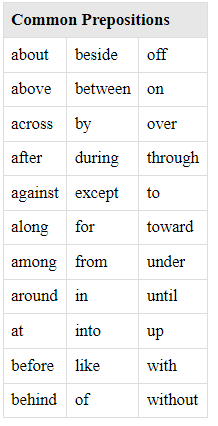






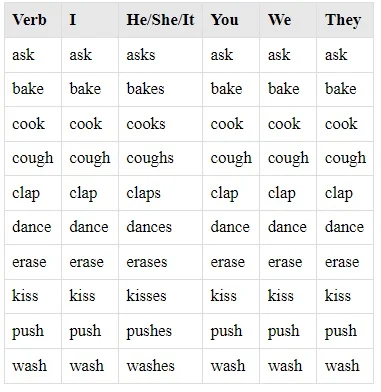
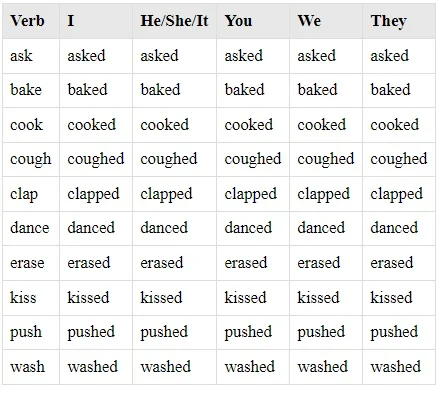
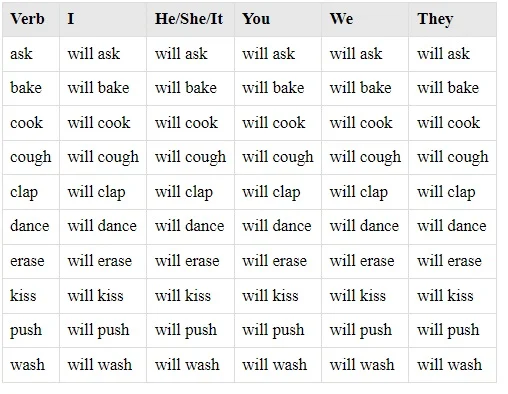



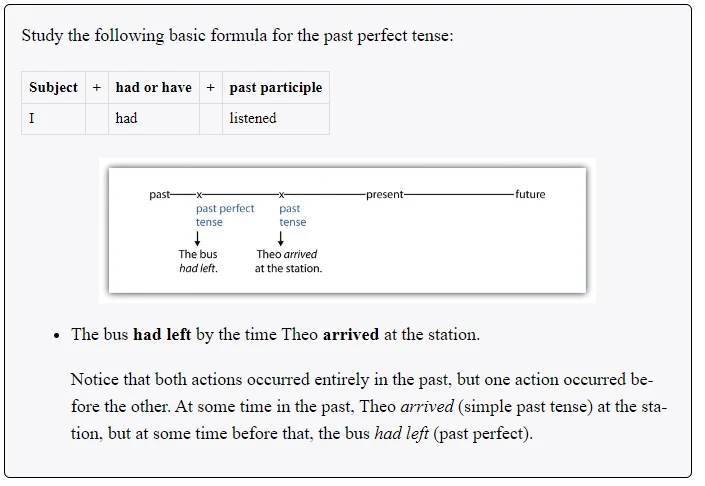
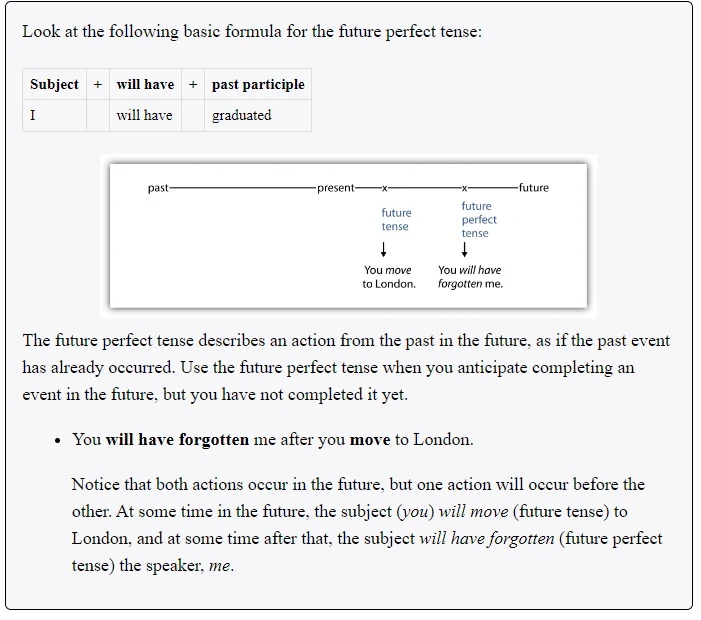
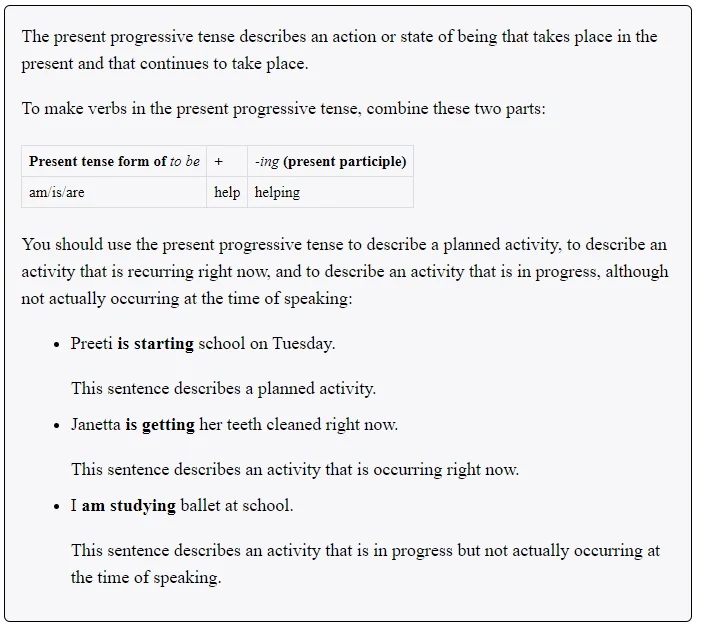
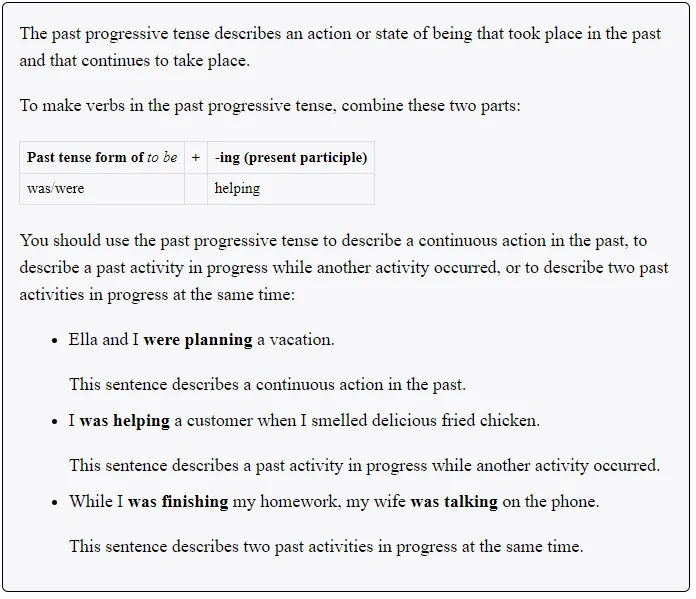


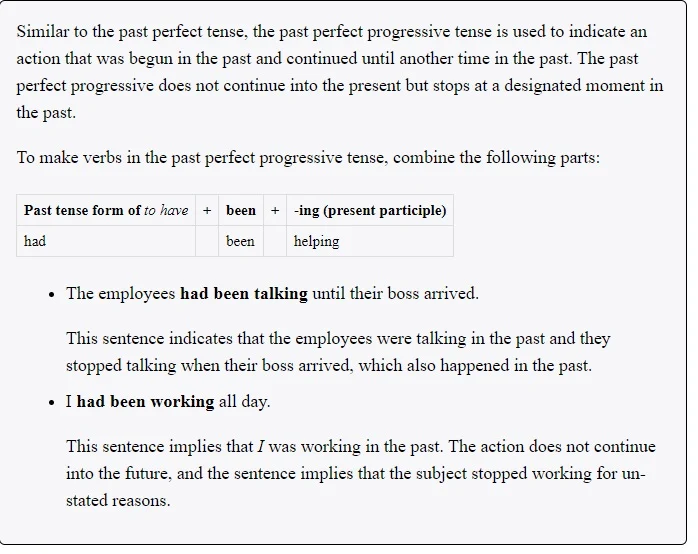

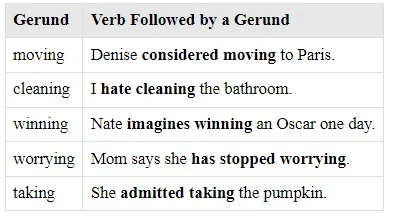
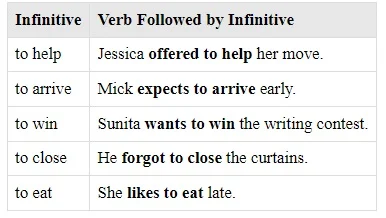

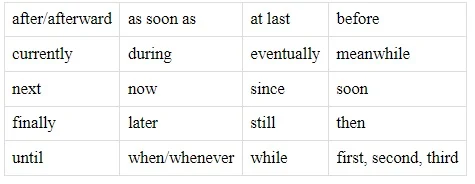
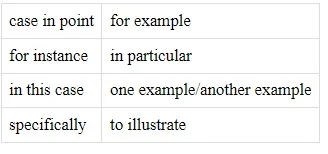

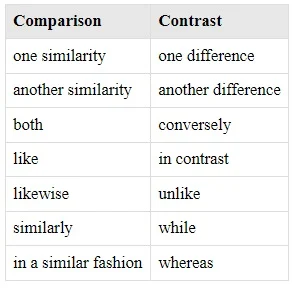


Comments
Post a Comment